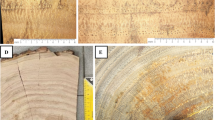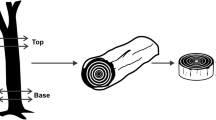Summary
The microscopic investigation in navashin-fixed material of Beilschmiedia tawa has shown that this species is a typical example of a tree with facultatively colored heartwood. Microtechnological measurements, as for instance of the shrinkage or the sorption or other features, have been proved suitable to determine whether or not the heartwood substances, which are formed in the storage tissue, have spread out into the cell walls of the surrounding tissues. Furthermore, it can be shown from the above mentioned results that cytological and physiological studies in wood must be based on the anatomical structure but may help at the same time towards a better understanding of this structure. The investigations in Beilschmiedia tawa are only one example of the suitability of subtropical or tropical timbers for this type of investigation. It may be hoped that, thanks to a close co-operation with research stations overseas, this beginning may be continued.
Zusammenfassung
Mikroskopische Untersuchungen von Holz von Beilschmiedia tawa zeigten, daß diese Holzart zu jener Gruppe gehört, für welche die Ausbildung eines Farbkerns typisch ist. Mikrotechnologische Messungen von Schwindung, Sorption oder anderen Holzeigenschaften erwiesen sich als geeignet zum Nachweis dafür, ob Kernholzsubstanzen, die im Speichergewebe gebildet worden sind, in die Zellwände des sie umgebenden Gewebes verlagert wurden. Die Ergebnisse zeigen ferner, daß die Kenntnis des holzanatomischen Gefüges stets die Grundlage zytologischphysiologischer Vorgänge bilden muß, daß diese Vorgänge aber ihrerseits zu einem besseren Verständnis der gefügemäßigen Gegebenheiten beitragen können. Die Holzart Beilschmiedia tawa ist nur eine unter vielen tropischen und subtropischen Holzarten, die sich für derartige Untersuchungen eignen. Es bleibt zu hoffen, daß durch enge Zusammenarbeit mit Forschungsstellen in aller Welt die hier begonnenen Arbeiten erfolgreich fortgeführt werden können.
Similar content being viewed by others
References
Bailey, I. W.: Contributions to Plant Anatomy. Chronica Botanica Vol. 15 (1954) p. 262.
Bosshard, H. H.: Der braune Kern der Esche. Holz als Roh-und Werkstoff Vol. 11 (1953) p. 349/353.
: Über die Anisotropie der Holzschwindung. Holz als Roh-und Werkstoff Vol. 14 (1956) p. 285/295.
—Mosaikfarbkernholz in Fagus silvatica L. Schweiz. Zeitschr. f. Forstwesen Vol. 116 (1965) p. 1/11.
—Aspects of the Aging Process in Cambium and Xylem. Holzforschung Vol. 19 (1965) p. 65/69.
Bosshard, H. H.: Notes on the Biology of Heartwood Formation. I.A.W.A.-Bulletin 1966, No. 1, p. 11/16.
Bosshard, H. H.: Über die fakultative Farbkernbildung. Holz als Roh-und Werkstoff Vol. 25 (1967) (in print).
Branton, D., and H. Moor: Fine Structure in Freeze-Etched Allium cepa L. Root Tips. Int. Ultrasctruct. Res. Vol 11 (1964) p. 401/411.
Braun, H. J.: Entwicklung und Bau der Holzstrahlen unter dem Aspekt der Kontakt-Isolations-Differenzierung gegenüber dem Hydrosystem: I. Das Prinzip der Kontakt-Isolations-Differenzierung. Holzforschung Vol. 21 (1967) p. 33/37.
Brazier, J. D., and G. L. Franklin: Identification of Hardwoods. Forest Prod. Res. Bull. No. 46, London 1961, p. 96.
Chattaway, M. M.: The Sapwood-Heartwood Transition. Australian Forestry Vol. XVI (1952) p. 25/34.
Frey-Wyssling, A., and H. H. Bosshard: Cytology of Ray Cells in Sapwood and Heartwood. Holzforschung Vol. 13 (1959) p. 129/137.
Harris, J. M.: 1966 (personal note).
Huber, B., und C. Rouschal: Mikrophotographischer Atlas mediterraner Hölzer, p. 105. Berlin 1954: F. Haller.
Hugentobler, U. H.: Zur Cytologie der Kernholzbildung. ETH Diss. 3639, 1965.
Reeve, R. M.: Histochemical Tests for Polyphenols in Plant Tissues. Stain Technology Vol. 26 (1951) No. 2.
—Histological and Histochemical Changes in Developing and Ripening Peaches: I. The Catechol Tannins. Am. J. of Botany Vol. 46 (1959) p. 210/217.
—Histological and Histochemical Changes in Developing and Ripening Peaches: II. The Cell Walls and Pectins. Am. J. of Botany Vol. 46 (1959) p. 241/248.
—Histological and Histochemical Changes in Developing and Ripening Peaches: III. Catechol Tannin Content per Cell. Am. J. of Botany Vol. 46 (1959) p. 645/650.
Stewart, C. M.: The Chemistry of Secondary Growth in Trees. Div. of Forest Prod., Techn. Paper No. 43, Melbourne 1966, p. 107.
Ziegler, H.: Biologische Aspekte der Kernholzbildung. Holz als Roh-und Werkstoff Vol. 26 (1968) p. 61/68.
Zirkle, C.: Vacuoles in Primary Meristems. z. f. Zellforschung u. mikr. Anat. Vol. 16 (1932) p. 26/47.
Author information
Authors and Affiliations
Rights and permissions
About this article
Cite this article
Bosshard, H.H. On the formation of facultatively colored heartwood in Beilschmiedia tawa . Wood Science and Technology 2, 1–12 (1968). https://doi.org/10.1007/BF00366408
Received:
Issue Date:
DOI: https://doi.org/10.1007/BF00366408




